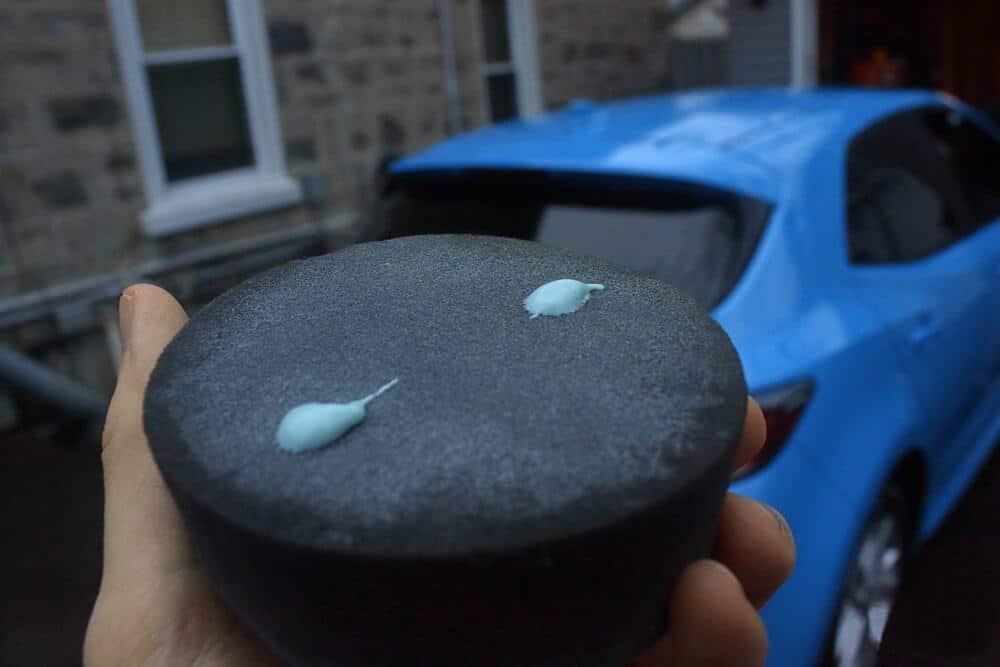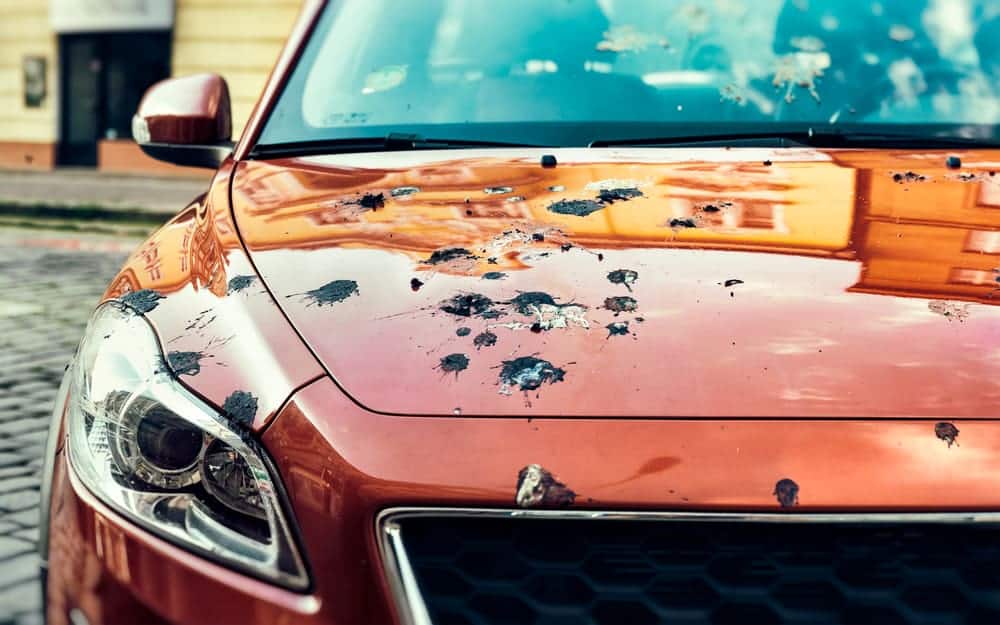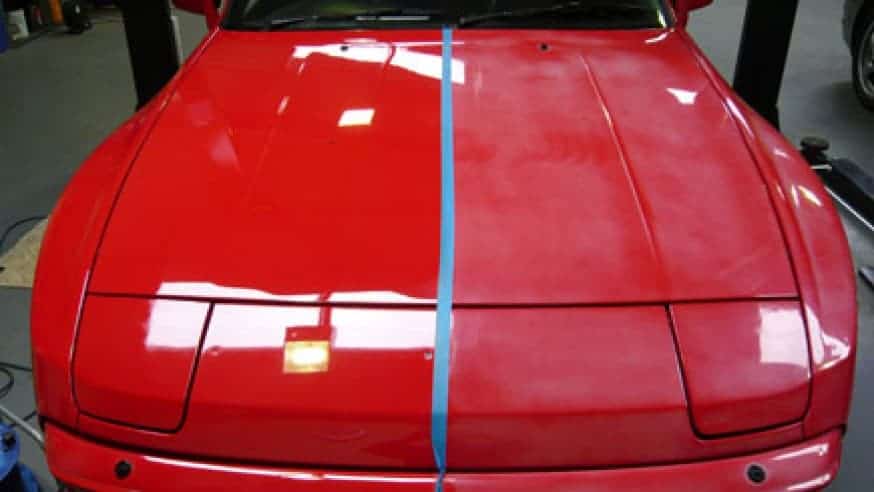Contrary to the popular myth, acid rain is indeed a real thing. While it’s not as potent as you’d see in a cheesy 1980’s Sci-Fi movie, rain that has trace amounts of acidic components happens daily across the globe. When the liquid is on the right side of that dreaded pH scale, it can cause havoc on automotive paint and other surface materials.
There are multiple sources of acid rain – ranging from smog and carbon emissions to cow farts (allegedly). And while the whole world remains on the fence about the reality of climate change, the truth is, our daily drivers and weekend warriors are prone to damage due to the harsh environments.
To offer a layer of protection, many car owners use a ceramic coating kit like Armor Shield IX to provide a hard, thin, and invisible shield over clear coats, plastic, vinyl wraps, glass, even headlights, and wheels. Doing so will not protect from rock chips or eliminate stains, but a ceramic coating application repels water, prevents acid rain from penetrating to the materials, reducing the potential of oxidation, and thus, keeping the surface protected.
In this article, we’ll explain how nano-ceramic coatings help to protect virtually anything automotive from acid rain. We will outline a few reasons why using a high-quality ceramic glass coating like Armor Shield IX is far superior to waxing your car, wax or sealant products, paint sealants, or other short-term paint protection options.
We’ll also explain some facts about acid rain, road salt, and other contaminants – so if nothing else, you’ll be educated and you can post your knowledge on twitter.
Breaking Down the Facts About Acid Rain
So, you clicked on this article to learn about ceramic coatings – cool, but let’s start with some scientific education. Acid rain is also called acid deposition, or a broad term that covers multiple forms of precipitation (rain) that includes some components of acidic nature. Some of the most common acids found in rain include nitric acid or sulfuric acid.
The truth is that all rain is contaminated with some levels of acid. Whether you live in a bustling metro area or a seamlessly pure rain forest, there are multiple contaminants in the air that blend with falling rain to create acid rain. While some wax or sealant products can help reduce damage, it’s not a 100% solution.
However, what is not commonly known about acid rain is that it doesn’t need to rain in order for acidic contaminants to hit your paint. In fact, damage can be caused by dry weather, fog, snow, hail, or even dust with acidic levels.
What Causes Acid Rain?
According to the US EPA, acid rain results when sulfur dioxide (SO2) and nitrogen oxides (NOX) are emitted into the atmosphere and transported by wind and air currents. The SO2 and NOX react with water, oxygen and other chemicals to form sulfuric and nitric acids. These then mix with water and other materials before falling to the ground.
So – let’s introduce some facts as to what causes the excessive levels of SO2 and NOx. Contrary to the popular myth, it’s not all about the fuels we burn. In fact, a fairly large percentage of acids are produced by natural sources, such as volcanic activity caused by hot springs, volcanic vents or volcano’s eruptions themselves.
But man-made sources including the burning of fossil fuels for energy production represent 2/3rd of SO2 production and ¼ of NOx. Vehicles and heavy equipment with diesel or gasoline-powered engines also produce emissions. Manufacturing, oil refineries, and others also contribute to the contaminants that cause acid rain.
How is Acid Rain Measured?
So, we all understand now what causes acid rain. But what determines the strength of acid rain, and thus, how it impacts the ability to screw up your paint job? Well, Acidity and alkalinity are measured using a pH scale – where 7.0 is considered to be neutral. The lower a substance’s pH (less than 7), the more acidic it is; the higher a substance’s pH (greater than 7), the more alkaline it is. That’s called a base for that keeping count of their 9th-grade chemistry notes.
Normal rain has a pH of about 5.6, which lends credence to our earlier statement that most rain is naturally ‘acidic. Most rain is slightly acidic because carbon dioxide (CO2) dissolves into it forming weak carbonic acid. In order to be considered ‘Acid Rain; it usually requires a pH between 4.2 and 4.4. For comparison, bird dropping is measured at 4.6 pH.
How to Protect Your Car from Acid Rain

As you can see – acid rain is a real deal threat. So, how can you protect your car and its exterior components from the damage done by higher acidic levels?
Basically, there are a few different options.
Car Wax

Many older car owners appreciate the value of natural carnauba wax. Natural wax was introduced to the car culture about 70 years ago. It’s fairly inexpensive and does a great job of protecting the paint from UV rays, chemicals and yes – acid rain. The problem, however, is that waxes last only a few months.
Paint Sealant

The Gen X consumer was introduced to paint sealants back in the 1990s when parachute pants were a real deal struggle. Essentially, paint sealants are hybrid formulations of car wax products, synthetically created to last about 8 to 12 months (or three times longer than natural car wax).
Ceramic Coatings

The automotive world was introduced to the power of quartz or ceramic coatings in the early 2000s. Initially, this durable polymer or synthetic created product was a professionally applied solution, that could only be installed by certified detailers. The reason was simple, professional-grade ceramic coatings were very difficult to install, as it applied a smooth surface with very little opportunity for problems.
There are some that offer lifetime warranty and others that are applied and wipe away that can last only a few years. The window of coated application temperature, time, and other variables for professional protection product make it quite difficult to apply correctly. The main ingredient is silicon dioxide or SIO2.
However, in recent years, many manufacturers have created DIY ceramic coatings, that are engineered for simplicity of application. They provide a surface tension or a hard shell of protection that blocks exposure to UV Rays, bird shit, bug splatters, and other contaminants – even acid rain. It also delivers a deep gloss finish, can be used on a windshield and can reduce scratching.
Why Should You Protect the Vehicle from Acid Rain?

Acid rain is not friendly to your vehicle. Excessive pH levels will eventually eat the protective layer of a clear coat or other synthetic coatings applied to OEM equipment. Since all rain has some levels of acidity and is naturally stronger to the dark side of paint corrosion, it’s important to apply some sort of protection to reduce the potential of damage.
When acid slowly eats away at automotive components, it creates the potential to provide bare spots, which can be exposed to the elements. This eventually increases the potential of oxidation or the opportunity to cause the paint to fade, metal to rust, or other materials to wear down thinner than they should.
How Well Do Paint Protection Products Protect Against Acid Rain?

If there is one item that causes excessive damage to paint protection products – it is acids. Acidic levels that are stronger than a pH of 4 represent a real threat to paint protection products. However, as lower acid rain levels (and remember – the lower the pH – the stronger the impact) – continually hit the vehicle, the progressive damage will occur.
With regard to how well they hold up, well – it really depends on the product used. Car wax tends to hold up to frequent rain and acidic input for about six weeks. Paint sealant can last up to eight months to a year. Ceramic coating products – when applied correctly and prepped as recommended, can last from three to five years and provide exceptional peace of mind.
What are the Best Ceramic Coatings to Protect Cars from Acid Rain?

If you’re going to apply a ceramic coating to your vehicle for the sole purpose of protecting against acid rain, there are a few important factors to determine.
First and foremost, do you have the time, patience, and ability to complete this on your own? There are some exceptional ceramic coatings that are sold by companies like AvalonKing that can be applied by the owner themselves. They are engineered to allow average car consumer to apply to their vehicles, with nominal prep work and some important application procedures.
If you have a covered garage and can apply the coating in temperatures from 50 to 80 degrees F, and without direct exposure to sunlight, the DIY option is a good fit. This type of ceramic coating will also require a certain amount of prep work. In most cases, the prep process for applying a DIY ceramic coating follows this method:
- Washing: The first step is to wash the vehicle using the two-bucket method. This helps to remove all surface contaminants and reduce the potential of swirl marks and other paint damage.
- Clay Bar: The second step is to clay bar to treat the vehicle. Clay bars or clay mitts are used to debris the vehicle surface by digging deep into those microscopic imperfections that become trapped in clear coats and other vehicle surfaces.
- Polishing: Sometimes, paint damage like swirl marks or minute scratches are embedded in the clear coat and need to be removed prior to applying a ceramic coating. To fix it, you’ll need to complete paint correction. This article gives a detailed process for DIY paint correction if you’re so inclined.
- IPA Spray: The final prep step is to complete an IPA or isopropyl alcohol spray treatment. This will remove any polish, wax, or cleaners from the surface area, which provides a clean surface to apply the ceramic coating.
If you’re willing and able to complete the steps above, you can feel confident in buying a high-quality DIY ceramic coating like Armor Shield IX.
Armor Shield IX is sold in a 30ml kit, that includes the ceramic coating, protective gloves, application sponge, multiple application cloths, and microfiber towel for buffing. We offer volume discounts for multiple kit purchases, for those larger vehicles that require the extra product.
However, arguably the best reason to choose Armor Shield IX is our customer service. We go above and beyond for our customers, offer lightning-fast, free shipping to North America consumers in the US and Canada, and have a ton of application, prep work, and aftercare tips for all types of projects.
Wrapping it Up
So, acid rain is basically a daily occurrence across the globe. No – it doesn’t instantly vaporize your paint, but it gradually starts to eat away at your unprotected paint, vinyl wrap, headlights, and plastic trim. If left unprotected, a vehicle can discolor or eventually oxidize quicker and lead to a piece of shit car.
The best way to prevent this is to take some pride in your daily driver by applying a ceramic coating. Whether you do it yourself or have a dealer do it for you, this is by far the best – and most cost-effective way of reducing damage.
If you’re going to spend the money on a good DIY coating like Armor Shield IX, just make sure you’re prepared to do it correctly – so you get the best bang for your buck.












